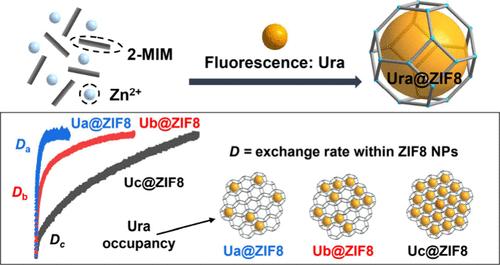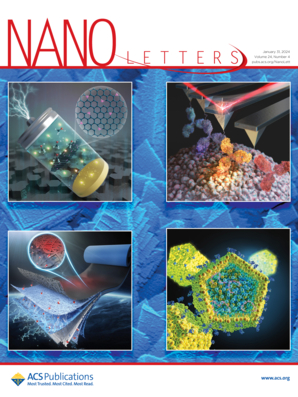The Throttle Effect in Metal–Organic Frameworks for Distinguishing Water Isotopes
IF 9.6
1区 材料科学
Q1 CHEMISTRY, MULTIDISCIPLINARY
引用次数: 0
Abstract
Metal–organic frameworks (MOFs) have been widely used for separation, but amplifying subtle differences between similar molecules to achieve effective separation remains a great challenge. In this study, we utilize the fluorescent molecule uranine (Ura) to modulate the pores of zeolitic-imidazolate framework 8 (ZIF8), creating an unusual throttle effect. By monitoring fluorescence intensity changes in Ura, the transport diffusion process could be quantified to reveal the diffusion constant of solvents. When we pushed the Ura occupancy to its limit (from 59% to 76% and 98%), the diffusion rate decreases by 2 orders of magnitude. Most importantly, there is a significant dissymmetry between the two-way exchange rates of solvents, and the rates of H2O and D2O became distinguishable. Such unusual throttle effects disappear at low Ura occupancy of 59% and 76%. We believe that the throttle effect with small-molecule loading could provide a universal design principle for MOF-based applications, especially for isotope separation.

用于区分水同位素的金属有机框架中的节流效应
金属有机框架(MOFs)已被广泛用于分离,但如何放大相似分子之间的微妙差异以实现有效分离仍是一项巨大挑战。在这项研究中,我们利用荧光分子尿氨酸(Ura)来调节沸石-咪唑啉框架 8(ZIF8)的孔隙,从而产生了一种不同寻常的节流效应。通过监测 Ura 的荧光强度变化,可以量化传输扩散过程,从而揭示溶剂的扩散常数。当我们将 Ura 占有率推至极限(从 59% 提高到 76% 和 98%)时,扩散速率会降低 2 个数量级。最重要的是,溶剂的双向交换速率明显不对称,H2O 和 D2O 的交换速率变得截然不同。这种不寻常的节流效应在 Ura 占有率较低时(59% 和 76%)会消失。我们相信,小分子负载的节流效应可以为基于 MOF 的应用,尤其是同位素分离,提供一种通用的设计原则。
本文章由计算机程序翻译,如有差异,请以英文原文为准。
求助全文
约1分钟内获得全文
求助全文
来源期刊

Nano Letters
工程技术-材料科学:综合
CiteScore
16.80
自引率
2.80%
发文量
1182
审稿时长
1.4 months
期刊介绍:
Nano Letters serves as a dynamic platform for promptly disseminating original results in fundamental, applied, and emerging research across all facets of nanoscience and nanotechnology. A pivotal criterion for inclusion within Nano Letters is the convergence of at least two different areas or disciplines, ensuring a rich interdisciplinary scope. The journal is dedicated to fostering exploration in diverse areas, including:
- Experimental and theoretical findings on physical, chemical, and biological phenomena at the nanoscale
- Synthesis, characterization, and processing of organic, inorganic, polymer, and hybrid nanomaterials through physical, chemical, and biological methodologies
- Modeling and simulation of synthetic, assembly, and interaction processes
- Realization of integrated nanostructures and nano-engineered devices exhibiting advanced performance
- Applications of nanoscale materials in living and environmental systems
Nano Letters is committed to advancing and showcasing groundbreaking research that intersects various domains, fostering innovation and collaboration in the ever-evolving field of nanoscience and nanotechnology.
 求助内容:
求助内容: 应助结果提醒方式:
应助结果提醒方式:


